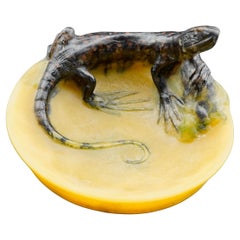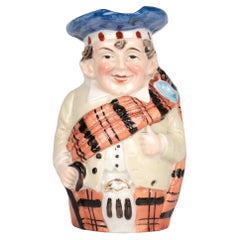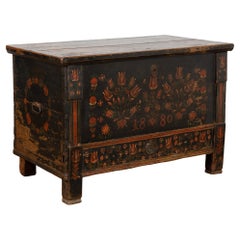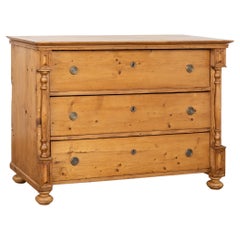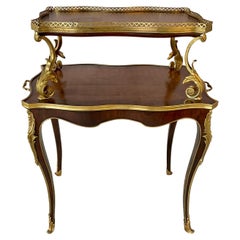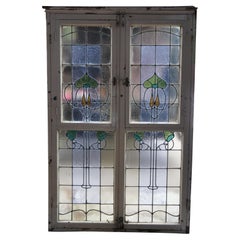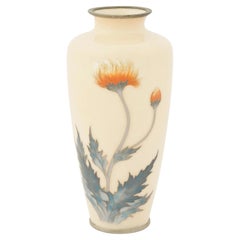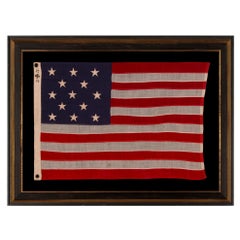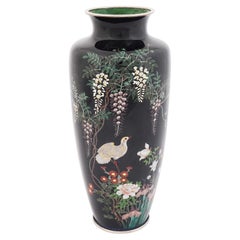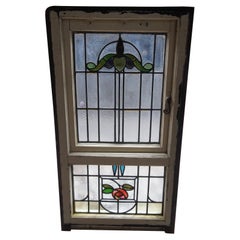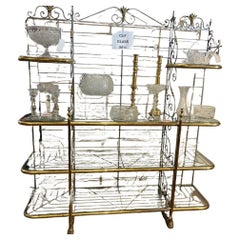Late 19th Century Furniture
to
8,444
26,126
20,704
48,814
5,697
1,667
1,405
1,102
1,092
682
607
499
444
439
309
191
164
118
115
53
40,560
134,857
550,863
285,629
85,776
261,161
125,550
12,812
5,641
18,699
22,922
19,647
54,199
72,475
61,148
21,623
9,226
16,249
15,771
10,003
7,274
6,566
28,639
13,123
10,178
8,004
5,844
48,814
48,814
48,814
151
147
142
140
111
Period: Late 19th Century
Monumental Antique Victorian Art Nouveau Leaded Stained Glass Window French Door
Located in Dayton, OH
A rare and exceptional reclaimed large two part leaded stained glass French Door / Window. Features a large rectangular frame with two 2-part hinged doors with separate operating win...
Category
High Victorian Antique Late 19th Century Furniture
Materials
Lead
$3,000 Sale Price
20% Off
Antique Meiji Era Japanese Cloisonné Enamel Vase
Located in Long Island City, NY
A rare elegant Japanese vase cast of metal, possibly brass, featuring a baluster shaped body and a wide short neck. The surface is decorated with a delicate image of a thistle flowe...
Category
Japanese Meiji Antique Late 19th Century Furniture
Materials
Metal
13 Star Antique American Flag, Inscribed "Spenge" ca 1895-1926
Located in York County, PA
13 STAR ANTIQUE AMERICAN FLAG WITH A 3-2-3-2-3 CONFIGURATION OF STARS ON AN ATTRACTIVE, INDIGO BLUE CANTON; A SMALL-SCALE EXAMPLE OF THE 1895-1926 ERA, INSCRIBED WITH THE SURNAME “SP...
Category
American Antique Late 19th Century Furniture
Materials
Wool
Antique Large Japanese Wire Cloisonné Enamel Vase
Located in Long Island City, NY
Antique large Japanese vase of elongated shape. Late Meiji period, 1868-1913. The piece is decorated with silver wire cloisonne enamel boughs of wisteria flowers and birds against a ...
Category
Japanese Meiji Antique Late 19th Century Furniture
Materials
Enamel
Antique Victorian Art Nouveau Leaded Stained Glass Window Floral Hinged Door 50"
Located in Dayton, OH
Exquisite reclaimed two part late 19th century leaded stained glass window. Features a large rectangular frame with a large hinged window / door over a transom. Each window is design...
Category
Victorian Antique Late 19th Century Furniture
Materials
Lead
$1,440 Sale Price
20% Off
19Thc Amazing Brass & Iron Large Bakers Rack
Located in Los Angeles, CA
This fine and very large French style bakers rack is in fine condition.This rack / shelf has custom made sized glass. This rack is in very good condition. This is the largest bakers ...
Category
American French Provincial Antique Late 19th Century Furniture
Materials
Iron
Meiji Japanese Cloisonne Turquoise Enamel Japanese Garden Vase Silver Wire
Located in Long Island City, NY
A high quality Japanese, late Meiji era, silver wire and enamel vase. The amphora shaped vase is adorned with polychrome enamel images of birds, trees, blossoming flowers, and screen...
Category
Japanese Meiji Antique Late 19th Century Furniture
Materials
Enamel, Silver
Antique Golden Age Japanese Cloisonne Enamel Chrysanthemums And Sparrows Vase
Located in Long Island City, NY
An antique Japanese, late Meiji era, footed enamel over copper vase in the Hayashi Tanigoro manner, c.1895 to 1935, a Japanese artist.
The urn shaped vase is enameled with a polyc...
Category
Japanese Meiji Antique Late 19th Century Furniture
Materials
Enamel, Copper
Large Antique Meiji Japanese Cloisonne Enamel Dragon Vases Signed
Located in Long Island City, NY
A fine quality Japanese metal vase from the time of Emperor Meiji, 1868 to 1912. Of a baluster form with slightly lobed shoulders, the body is adorned with a finely detailed shaded c...
Category
Japanese Meiji Antique Late 19th Century Furniture
Materials
Metal
Antique Diebold Safe & Lock Company Small Cast Iron Floor Safe Working Ohio 24"
Located in Dayton, OH
Late 19th Century Diebold Safe & Lock Company Cast Iron Floor Safe. Features a heavy black cast iron frame with gold trim. The safe has a working combo lock and opens to a gold tri...
Category
American American Classical Antique Late 19th Century Furniture
Materials
Iron
$2,000 Sale Price
20% Off
Pair Antique Dutch Delft Jars Blue and White Thousand Flowers Pattern Ca. 1880
By Delft
Located in Katonah, NY
This pair of large antique Dutch Delft jars, made circa 1880, features classic blue and white Delft decoration in the "Thousand Flowers" pattern.
The decoration presents a continuous...
Category
Dutch Rococo Antique Late 19th Century Furniture
Materials
Delft
Pair Large Antique Blue and White Delft Jars, Fluted, Netherlands Circa 1880
By Delft
Located in Katonah, NY
This exquisite pair of large blue and white Delft jars was hand-painted in the Netherlands during the late 19th century, around 1880.
The design features shaped panels, each depicti...
Category
Dutch Rococo Antique Late 19th Century Furniture
Materials
Delft
Antique French Silver Horse Head Walking Cane Stick 19th Century 90cm 35.5inches
Located in London, GB
This is a fantastic antique French horse head silver topped walking stick, with .925 silver import mark, late 19th century in date.
The striking stick features an ornate silver croo...
Category
French Antique Late 19th Century Furniture
Materials
Silver, Brass
Antique Chromolithograph of Marine Life with Coral, Fish and Sea Creatures, 1890
Located in Langweer, NL
Antique Chromolithograph of Marine Life with Coral, Fish, and Sea Creatures, ca. 1890
This engaging and finely detailed chromolithograph, titled “Das Leben im Meere” (Life in the Sea), dates to around 1890 and illustrates a vibrant array of marine animals in their underwater habitat. Rendered in striking full color, this educational plate combines artistic beauty with scientific accuracy, representative of late 19th-century natural history imagery used in schools, encyclopedias, and popular science publications.
The composition features an impressive diversity of sea creatures and plant life, carefully labeled with corresponding letters. In the foreground, prominent figures include a large green lobster (g. Hummer), a sea turtle (a. Meerschildkröte), and a large crab (e. Großer Taschenkrebs), all shown in highly naturalistic detail. Surrounding them are other fascinating marine organisms such as a squid (h. Tintenfisch), starfish (k. Seesterne), shrimp (f. Garneele), sea urchins (i. Seeigel), sea anemones (m. Seeanemonen), jellyfish (l. Schirmquallen), and colorful coral (n. Edelkoralle). Also depicted are a seahorse (d. Seepferdchen), a flatfish or sole (b. Goldbutte), and a herring (c. Hering), among others.
Beyond the foreground, the underwater world fades into an atmospheric gradient, with swaying sea plants, drifting jellyfish, and distant ships visible at the water’s surface. The overall composition is both decorative and informative, capturing the sense of wonder and discovery associated with marine biology during the 19th century—a period of growing interest in the natural sciences.
Such prints were prized not only for their educational value but also as art objects. Today, this image appeals to collectors of antique scientific illustrations...
Category
German Antique Late 19th Century Furniture
Materials
Paper
Large Antique Jardinière, Japanese, Bronze, Tree Planter Pot, Victorian, Meiji
Located in Hele, Devon, GB
This is a large antique jardinière, a Japanese bronze planter pot with rich relief decoration, dating to the Victorian period, circa 1880.
Of generous proportion, ideal for interior...
Category
Japanese Meiji Antique Late 19th Century Furniture
Materials
Bronze
Pair Of Meiji Japanese Cloisonne Enamel Vases Kyoto School
Located in Long Island City, NY
A pair of Japanese cloisonne enameled brass vases. They feature a narrow neck, rounded body, and are decorated with an intricate pattern of floral designs in various colors, and gilt...
Category
Japanese Antique Late 19th Century Furniture
Materials
Brass, Enamel
Original Antique Botanical Print- Roses. After Macfarlane, circa 1880
Located in St Annes, Lancashire
Great image of roses
Chromo-lithograph after J.L Macfarlane
Published by Cassell. circa 1880
Unframed. It gives you the option of perhaps making a set up using your own choice of ...
Category
English Victorian Antique Late 19th Century Furniture
Materials
Paper
Late 19th Century French Art Nouveau Period Painted Iron and Marble Bistro Table
Located in Fayetteville, AR
Originally used in a French brasserie during the late nineteenth century, this white enameled cast iron bistro table or cafe table features a solid white oval marble top with grey ve...
Category
French Art Nouveau Antique Late 19th Century Furniture
Materials
Marble, Iron
Late 19th C French Carved and Bleached Oak Buffet
Located in Troy, MI
Found in France, this oak buffet cabinet dates from the 1880s. Constructed of old French oak that has been lightly bleached, stripped of finish and sanded smooth. Three hinged and lo...
Category
French Antique Late 19th Century Furniture
Materials
Oak
Late 1800s Chinese Lacquer Screen Room Divider H224cm W320cm
Located in London, GB
Large 8-winged lacquer shade, richly carved with garden scenes, symbols, ornamentation, trees and birds. Second half of the 19th century. H. 224 W. 320 cm. Age-related wear; marks, c...
Category
Chinese Qing Antique Late 19th Century Furniture
Materials
Lacquer
Late 19th Century French Louis Philippe Style Book Matched Walnut Sideboard
Located in Fayetteville, AR
This late nineteenth century French Louis Philippe style enfilade or sideboard is constructed of solid walnut with hand pegged joinery. This server features three book matched walnut...
Category
French Louis Philippe Antique Late 19th Century Furniture
Materials
Iron
Set of 14 19th and 20th Century French Apothecary Bottles
Located in Mckinney, TX
A striking collection of 14 antique French apothecary bottles, dating from the late 19th to early 20th century. Each glass vessel once held medicinal powders, tinctures, or remedies,...
Category
French Antique Late 19th Century Furniture
Materials
Glass
Monumental Sofa in Patinated Brown Leather, Studs and Velvet Late 19th Century
Located in Meer, VAN
Monumental Sofa in Patinated Dark Brown Leather, Brass Studs and Velvet Late 19th Century
A very remarkable and monumental late 19th century sofa in patinated dark brown leather, st...
Category
European Arts and Crafts Antique Late 19th Century Furniture
Materials
Brass
Exceptional American Flag, 38 Stars in 3 Sizes in a Fantastic, Unusual Medallion
Located in York County, PA
EXCEPTIONAL ANTIQUE AMERICAN FLAG WITH 38 GLAZED COTTON STARS, IN 3 DIFFERENT SIZES, ARRANGED IN A BEAUTIFULLY GRAPHIC, DOUBLE-WREATH STYLE MEDALLION, WITH TRIANGLES OF 4 STARS IN ...
Category
North American Antique Late 19th Century Furniture
Materials
Wool
Pair Antique French Louis XV Marquetry Marble Top Nightstands with Two Drawers
Located in Miami, FL
Pair Antique French Louis XV Marquetry marble top nightstands offer a lot of style in diminutive packages! The subtle contours and scroll forms are evident in the cornerposts and leg...
Category
French French Provincial Antique Late 19th Century Furniture
Materials
Marble
Antique French Art Nouveau Silver Handled Walking Stick 19th Century
Located in London, GB
A superb antique French Art Nouveau silver handled walking stick, Circa 1880 in date.
It features astunning silver crook handle embossed with floral garlands with a decorative inse...
Category
French Art Nouveau Antique Late 19th Century Furniture
Materials
Silver
Exceptional French Ormolu-Mounted Turquoise Jeweled Sevres Porcelain Clock Set
Located in Long Island City, NY
An exceptional French bronze ormolu mounted turquoise jeweled Sèvres Porcelain clock set by Raingo Fres, Paris, circa 1880.
Comprising of a clock in vase form and a pair of five-l...
Category
French Antique Late 19th Century Furniture
Materials
Bronze, Ormolu
Original John Sollie Henry, armchair, London 1895
By Woka Lamps
Located in Vienna, AT
solid mahogany with polished finish, original brown leather; decorative knobs; strikingly high backrest with stylised decoration in bas-relief; rear legs curved, forelegs tapering do...
Category
British Jugendstil Antique Late 19th Century Furniture
Materials
Mahogany
Syracuse Safe Co. Yale Steel Combination Lock Safe with Painted Scene c1890
Located in Big Flats, NY
***Reduced In-House Delivery Rates - Click on “Ask Seller” to Request a Quote***
Syracuse Safe Co. Yale Steel Combination Lock Safe with Painted Scene c1890 (29" x 18 1/8" x 19 1/2")...
Category
Antique Late 19th Century Furniture
Materials
Steel
Antique Japanese Cloisonne Enamel Early Meiji Namikawa School Vase
Located in Long Island City, NY
An antique Japanese early Meiji period cloisonne vase, attributed to the renowned artist Namikawa Yasuyuki. Adorned with intricate floral motifs, delicate butterflies, and exquisite ...
Category
Japanese Meiji Antique Late 19th Century Furniture
Materials
Enamel
Antique Japanese Yosegi (Marquetry) Shibayama Ko Tansu Meiji Period
Located in Point Richmond, CA
Antique Japanese Yosegi (Marquetry) Shibayama Ko Tansu, Meiji period
The marquetry is composed of keyayaki (zelkova) and kakinoki (persimmon) wood. Two small doors with inlaid Moth...
Category
Japanese Meiji Antique Late 19th Century Furniture
Materials
Wood, Mother-of-Pearl, Lacquer
Antique 1899 Rookwood Pottery E.T. Hurley Orange Brown Floral Vase Urn 705 8"
Located in Dayton, OH
Antique 1899 Rookwood Pottery 705 ceramic flower vase by Edward Timothy Hurley. Simply styled vase with tapered base and flared mouth, decorated with a golden green to dark brown om...
Category
American Victorian Antique Late 19th Century Furniture
Materials
Pottery
19th Century Majolica Insects Musicians Jardinière
Located in Austin, TX
Unusual and humoristic 19th French Majolica jardinière with insects playing musicals instruments.
Decorated with leaves and flowers.
Category
French Rustic Antique Late 19th Century Furniture
Materials
Ceramic
George Trollope & Sons fireplace & room, Paris Exhibition 1878 Gold Medal Winner
Located in London, GB
George Trollope and Sons. Exhibited at the Paris Universal Exhibition in 1878 winning a Gold Medal for Excellence.
The set forms the four sides of a complete panelled room that was exhibited as a boudoir room or petit salon at the Paris Exhibition 1878 .
The main feature and centrepiece of this boudoir room is the Rosso Antico marble fireplace surmounted by an open display niche carved in cedar wood.
Each side of the room is composed of various panels and are as follows:
One side with a grand Rosso Antico marble fireplace flanked by two doorways.
One side with French doors originally opening onto a balcony, flanked by two large bookshelves.
One side with a window flanked by two mirrors. The opposite side with three large mirrors.
The complete room measures:
21 ft / 6.4 m wide, 17 ft / 5.18 m deep, and 12 ft / 3.65 m high.
It could also be used in a number of different combinations to suit various room layouts. The mirrors could be replaced with windows or further bookcases.
Each side is decorated with various sizes of finely carved panels and holds ornate Corinthian style columns surmounted with cherubim's on the capitals. Three cherubs are formed at the top of each corner with three columns, at the column bases there are circular carved pedestals to display statues.
Published & illustrated in the ‘Illustrated Catalogue of the Paris International Exhibition’.
The main part of this room, the Rosso Antico marble fireplace is surmounted by a large open display niche carved in cedar wood are illustrated with a line drawing in the Paris Universal Exhibition catalogue on page 209. The whereabouts of the seminaked caryatids and the marble bust of Alexander Pope are unknown. The bust of Alexander Pope was copied from the original one in Westminster Abbey, London.
The Corinthian columns now flanking the niche above the fireplace are also in cedar wood having the identical carved fluting to the rest of the room and were made to replace the caryatid figures. Those Corinthian columns are period to the room and can only have been made shortly after it arrived back to London and before it was reassembled and fitted into the house built by George Trollope and Sons in the 1880's, and where we removed it all from.
George Trollope made clever use of Alexander Pope's early 18th-century poetical successes in Great Britain and France by using ‘The Rape of Lock’, a mock-heroic narrative poem Pope wrote in 1712 about Petre who cut off a lock of Arabella’s hair without her permission, as the theme of the boudoir room or petit salon at the 1878 Paris Exhibition.
In the original exhibition display of the room set, tapestries depicting the Rape of Lock were hung where the mirrors are now positioned.
Alexander Pope's The Rape of the Lock is a humorous indictment of the vanities and idleness of 18th-century high society. Basing his poem on an actual incident among two families of his acquaintance, Pope intended his verses to quench hot tempers and to encourage his friends to laugh at their own foolishness.
The poem is an outstanding example in the English language of the genre of mock-epic. The 'epic' was considered one of the most serious of literary forms; it had been applied, in the classical period, to the trivialities of love and war. Pope’s mock-epic is not to mock the form itself, but to mock his society in its very failure to rise to epic standards, exposing its pettiness by casting it against the grandeur of the traditional epic subjects and the bravery and fortitude of epic heroes: Pope’s mock-heroic treatment in The Rape of the Lock underlines the ridiculousness of a society in which values have lost all proportion, and the trivial is handled with the gravity and solemnity that ought to be accorded to truly important issues. The 18th-century society in this poem fails to distinguish between things that are important and things that are not. The poem mocks the men it portrays by representing them as unworthy of a heroic culture. Therefore the mock-epic follows the epic in that its main concerns are serious and moral. The point that the theme must now be satirical rather than earnest is symptomatic of how far the culture has fallen.
Retaining the original exhibition label
The back of the panelling still retains two original labels printed with the 'Union Jack' and printed adjacent to it, 'The Secretary Royal British Commission for the Universal Exhibition 1878 Champ de Mars Paris'.
Adjacent to that and below, printed and written in ink vertically:
Exhibitor: (and signed in ink) George Trollope & Sons.
Address: (written in ink) Halkin Street West. London.
Allotment in Block: (written in ink) a2. In the printed floor plan 'a2 square' is in the very first line to the right of the floor plan and handwritten in ink with a 'diamond shape' also written with '101' within it. This pin points where George Trollope's stand was located.
With thousands of items being displayed at the Exhibition, this label would have been the floor plan for the craftsmen, so they knew the correct place to install the boudoir room or petit salon.
The firm continued expanding house building and interior decoration side of the business and by 1849 was also trading as an estate agency, letting and controlling property for the Grosvenor Estates. A separate branch of cabinet-makers, bearing the family name, was opened at West Halkin Street, London. becoming known as 'The Museum of Decorative Arts' (looked after by George Robinson). Here Trollope and Sons also sold high-class antique furniture made by other makers. In 1851, the firm became formally known as George Trollope and Sons. West Halkin Street, London. The address was recorded in the listing for the firm in The Furniture Gazette Directory, 1876 & 1877.
Period Press Coverage & Art Critic Review.
everal newspapers also thoroughly describe George Trollope and Son's stand including the different tapestries that were hung where the mirrors are now, illustrating the poem 'The Rape of Lock', by Alexander Pope.
Marius Vachon, a French Art Critic and journalist, who wrote for the journal ‘La France’ published an extensive review of the Trollope and Sons stand in a book called Les Merveilles de l'Exposition de 1878 (The Wonders of the 1878 Exhibition).
Note: In the World Fairs translation it states door frame, Marius Vachon had originally written ‘chambranle’ in French, 'chambranle' loosely translates to a frame around something, and should read in its correct context: ‘fireplace in rosso antico’.
We have taken the extract below written by Marius Vachon in its translated form from: Les Merveilles de l'Exposition de 1878, (The Wonders of the 1878 Exhibition). This puts into perspective the importance of this fine quality room interior when he viewed it at the exhibition in 1878:
Marius Vachon: English furniture is very curious to observe; irreproachable from the point of view of execution, the furniture of our neighbours always reaches the last degree of respectability and comfort. One thing to be noticed is that for large pieces of furniture, the English upholsterer is transformed into a sort of architect; everything he makes takes on a monumental aspect.
The first object that catches the eye when one enters the furniture class is the beautiful boudoir-salon exhibited by Mr. Trollope. The boudoir (or petit salon), of carved cedar wood, is an attempt to reproduce the style which prevailed in England during the first decade of Queen Anne's reign, and all the details have been studied, but not copied, from examples of decorative work of the time. The fireplace is in "rosso antico" movement, and the ceiling is in portable plaster. The panels painted on canvas represent scenes from the heroic-comic poem "The Abduction of the Hairpin," (The Rape of Lock) written by Alexander Pope in 1712, the eighth year of Queen Anne's reign, in which the customs and mores of the time are satirized in a pleasing manner.
The apotheosis of the Loop and its sidereal transformations will form the decoration of the ceiling. In these illustrations of Pope's charming poem, the costumes and accessories have been taken from models of the time; and the bust of the poet, copied from his tomb in Westminster Abbey, occupies the niche in the centre of the mantelpiece.
M. Marius Vachon, the period writer of the above continues with:
Now we shall mention at random the magnificent dining table of Messrs. Johnston and Co., their oak mantelpiece, their boudoir table; Mr. Watt's drawing-room mantelpiece stepped in the old style and imitating the Japanese; Mr. James Shoolbred's great
The Decorative Arts Society on Trollope and Sons
The boudoir or petit salon is mentioned again in the Decorative Arts Society:
Trollope did not exhibit such highly rated objects at the 1878 Paris Exhibition as at previous exhibitions; items included a large mirror frame carved in limewood in Renaissance style and a satinwood cabinet in Adam revival style, with a similar armchair (illus. Meyer (2006), p. 242) and probably two rooms; one was a boudoir in cedar wood in Queen Anne style and the other was a boudoir decorated by the firm in the theme of Pope’s The Rape of Lock.
In the above extract, it is quite clear that the two rooms mentioned are in fact the very same room, because the fireplace and niche are illustrated in The Paris Universal Exhibition catalogue on page 209 and Marius Vachon describes the rest of the room set in the above…
Trollope and Sons exhibition pieces listed and described by Meyer in an article he wrote for: The Decorative Arts Society 1850 to present, Journal 25 in 2001., where he points out the importance of George Trollope and Sons and mentions a table by Trollope exhibited at the 1867 exhibition that sold for £40,000 in 1996. He also mentions a cabinet exhibited by Trollope at the International Exhibition of 1862 that sold at Sotheby's in 1997 for £150,000.
Interest was not as strong in the 1990's as it is today for rare exhibition pieces, high quality items were abundant back then, it was a golden era when the most beautiful works of art just kept coming onto the market. But there are exceptions as in this instance, when a unique, gold medal-winning exhibition work of art comes onto the market for the very first time.
Meyer continued researching and writing about the great exhibitions and released his book in 2006, 'The Great Exhibitions, London, New York, Paris and Philadelphia 1851- 1900, where he mentions only in passing, The Boudoir Room or Petite Salon exhibited by Trollope, he even states that an image was not reproduced and that Trollope's exhibits in 1878 were not up to the quality and class of the items Trollope exhibited in London in 1862 and Paris in 1868. This is probably because Meyer didn't know of the line drawing illustrating the Roso Antico Fireplace, Niche and Panelling reproduced in The Illustrated Catalogue of the Paris International Exhibition 1878 shown in the above which Geering recently uncovered.
John Meyer continues in the DAS journal:
Undoubtedly they (Trollope) are a firm worthy of further research as they were right at the forefront of the furniture business in London from 1860 to 1880.
Our research shows that the Petite Boudoir was awarded the gold medal for excellence in 1878 (see Journal La Liberté 23-10-1878 with the list of all medals attributed), something George Trollope and Sons did not achieve at the London 1862 and the Paris 1867 exhibitions. Jonathan Meyer joined Bonham's in 1977. He was Director at Sotheby's in charge of 19th Century Furniture from 1994 to June 2007. He was also chairman of the Fine Arts Faculty for The Royal Institute of Chartered Surveyors.
In the original description from the article in Les Merveilles de l’exposition de 1878, M. Marius Vachon states:
The first object that catches the eye when one enters the (English) furniture class is the beautiful boudoir-salon exhibited by Mr. Trollope.
Suggesting, it was in his opinion the very best on display in the English section, and being awarded the gold medal for excellence can only add weight to this.
Adjacent to the original label that was printed by The Secretary - Royal British Commission for the Universal Exhibition 1878 in stencil ‘TO BE KEPT’, i.e. ‘to be returned’. This confirms why it came back to London. We removed the Boudoir Room or Petite Salon from a Trollope house, part of a grand high-class housing estate in London which around the time of the exhibition Trollope and Sons were in the process of building, and where the room set was installed directly after it returned from the exhibition in 1878 until now.
Worthy of note is the machines that did the carving for the Boudoir Room or Petite Salon and also did all of the decorative carving (most of which was linenfold carving) for the Houses of Parliament, London.
This machine, the engraving and description of which we copy from Engineering, was specially designed by its inventor, Mr. Jordan, for assisting in the production of the vast amount of carved decorations required for the walls and ceilings of the Houses of Parliament, London, and it was so employed during the entire progress of the work. The late Sir Charles Barry was so well satisfied with it, that he frequently declared it would have been impossible to have accomplished the work without it. The Department of Woods and Forests employed five of the machines at the Government Works, Thames Bank, for several years; and the machines have now passed into the hands of Messrs. George Trollope and Son, and are still used in the same building.
They also exhibited the new technique of xylatechnography and sgraffito, methods of impressing coloured design into soft wood and engraving veneer to reveal the base wood.
The newspaper, La Liberte October, 23rd 1878 listing the medal winners of the Paris 1878 exhibition. Third column, ''GROUPE III MOBILIER ET ACCESSOIRES'', (GROUP III FURNITURE AND ACCESSORIES). Medailles d'or. (Gold Medals) where G Trollope et fils (G Trollope and Sons...
Category
Antique Late 19th Century Furniture
Materials
Marble
Late 19th Century Figurine - Vienna Bronze - Cold-Painted - Birds on a Feather
Located in Casteren, Noord-Brabant
Delightful and finely detailed cold-painted Vienna bronze figurine depicting two young birds perched on a large feather. Dating to circa 1900, this charming piece exemplifies the exq...
Category
Austrian Belle Époque Antique Late 19th Century Furniture
Materials
Bronze
13 Star Commission Pennant, 6 Foot in Length, ca 1892-1910
Located in York County, PA
6-FOOT SHIP’S COMMISSION PENNANT WITH A 5.5” HOIST AND 13 STARS IN 2 STAGGERED ROWS, LIKELY PRODUCED FOR A PRIVATE VESSEL, circa 1892-1910
Commission pennants are the distinguishing...
Category
American Antique Late 19th Century Furniture
Materials
Wool
Large Japanese Totai Covered Cloisonne Enamel Porcelain Jar
Located in Long Island City, NY
A large Japanese covered Totai enamel on porcelain ginger jar. The ware is enamelled with polychrome floral and foliage ornaments made in the Cloisonne technique. The cover of the wa...
Category
Japanese Antique Late 19th Century Furniture
Materials
Enamel
19th French Majolica Pink Daisy Plate Delphin Massier
Located in Austin, TX
19th French Majolica Pink Daisy Plate Delphin Massier.
Category
French Art Nouveau Antique Late 19th Century Furniture
Materials
Ceramic
Japanese Antique Large Tansu / Cabinet Cupboard / 1868-1912s Wabi-sabi
Located in Iwate-gun Shizukuishi-cho, Iwate Prefecture
This is an old Japanese tansu.
It was used in the Tohoku region around the Meiji period, and the main material is pine wood.
It is believed to have originally been used as a cupboa...
Category
Japanese Meiji Antique Late 19th Century Furniture
Materials
Wood, Cedar, Chestnut, Pine
Antique English Sofa Console Table Bleached Jacobean Carved Oak Foyer Table
Located in Shreveport, LA
Antique English Sofa Console Table Bleached Jacobean Carved Oak Foyer Table.
Direct from Europe, a beautiful antique English sofa or foyer table, in solid oak, with a gorgeous patin...
Category
British Jacobean Antique Late 19th Century Furniture
Materials
Oak
Large Antique Walnut Perpetual Desk Calendar. English, C.1900
Located in St Annes, Lancashire
A fabulous walnut desk calendar
Lovely colour of wood
Good condition. All text and numbers complete
Free UK shipping
Category
English Edwardian Antique Late 19th Century Furniture
Materials
Walnut
$520 Sale Price
20% Off
19th Large Spanish Dining or Desk Table with Carved Legs and Wood Stretcher
Located in Miami, FL
19th Spanish refectory desk table with solid legs and wood stretcher
Original perfect condition
Top table in perfect condition
Very heavy piece
Category
Spanish Baroque Antique Late 19th Century Furniture
Materials
Walnut
Antique Wash Stand In Brass And Marble, Circa 1880
Located in Amsterdam, Noord Holland
Antique brass and marble washbasin from circa 1880. High quality brass and marble washbasin with compact proportions. Just right for a smaller bathroom or sink. Solid and strong. Has...
Category
French French Provincial Antique Late 19th Century Furniture
Materials
Carrara Marble, Brass
French Antique Ormolu and Limoges Enamel Jewellery Box
By Limoges
Located in Newark, England
LIMOGES ENAMEL PANELS
From our Decorative collection, we are delighted to offer this French Napoleon III Ormolu and Enamel Jewellery Box. The Jewellery...
Category
French Napoleon III Antique Late 19th Century Furniture
Materials
Enamel, Ormolu
Antique French Provincial Farmhouse Table
Located in Vero Beach, FL
Antique French Provincial Farmhouse Table
Late 19th century French plank top farmhouse table. The rustic table is made from well patinated solid oak wood proving both sturdy and att...
Category
Country Antique Late 19th Century Furniture
Materials
Oak
Japanese Meiji Period Carved Dragon Chair
Located in Houston, TX
Highly carved sculptural Meiji dragon armchair.: dragon motif carried throughout arms and chair with fantastic detailed hand carvings.
Category
Japanese Meiji Antique Late 19th Century Furniture
Materials
Wood
Zabihi Collection Antique Ziegler Mahal Persian 19th Century Carpet
Located in New York, NY
a late 19th century Ziegler Sultanabad Mahal room-size square rug
Details
rug no. 10809
size 8' 10" x 10' 1" (269 x 307 cm)
Woven in a series of villages in Western Central Iran, S...
Category
Persian Rustic Antique Late 19th Century Furniture
Materials
Wool
Rare Set of 5 Small 19th Century Majolica Flowers Vases Delphin Massier
Located in Austin, TX
Rare Set of 5 Small 19th Century Majolica Flowers Vases Delphin Massier.
2 pansies, 2 wild roses , 1 daisy.
Table vases decorations , very rare form and size.
Around 4 inches height ...
Category
French Art Nouveau Antique Late 19th Century Furniture
Materials
Ceramic, Majolica
Antique Victorian Renaissance Revival Walnut Burl Marble Top Dresser & Mirror
Located in Dayton, OH
A charming antique Victorian Renaissance Revival dresser & mirror, circa 1880s. Made from walnut with vibrant burled panels along the front and matchbook burling along the sides. Fe...
Category
Renaissance Revival Antique Late 19th Century Furniture
Materials
Brass
$2,000 Sale Price
20% Off
Victorian Triptych of Alpine Flowers from Alpine Plants by David Wooster 1874
Located in Langweer, NL
Victorian Triptych of Alpine Flowers from Alpine Plants by David Wooster 1874
This rare and visually striking triptych features three original hand-coloured lithographs from the cel...
Category
Antique Late 19th Century Furniture
Materials
Paper
English Grand Hall Bench or Window Seat of Patinated Oak
Located in Austin, TX
A fine English grand hall bench or country house window seat of patinated oak, featuring a rectangular top over a serpentine frieze with two facing cabriole legs and two straight leg...
Category
English Antique Late 19th Century Furniture
Materials
Wood, Oak
Large 16" Imari Charger, Meiji Period
Located in Pasadena, CA
This impressive large Imari Charger dates to the later Meiji period. The charger features a central reserve of a traditional Japanese flower basket which is surrounded by reserves of...
Category
Japanese Anglo-Japanese Antique Late 19th Century Furniture
Materials
Porcelain
Japanese Antique Meiji Period Hammered Silver Dragon Box
Located in Newark, England
Hammered Silver Decoration
From our Japanese collection, we are pleased to offer a Japanese Meiji Period Silver Dragon Box. The box of rectangular f...
Category
Japanese Meiji Antique Late 19th Century Furniture
Materials
Silver
Fire Screen in Patinated Brass Late 19th Century
Located in Tilburg, NL
Fire Screen in Patinated Brass Late 19th Century.
A very elegant and beautifully patinated fire screen in brass - late 19th century / early 20th century. A simple yet stylish design...
Category
European Neoclassical Antique Late 19th Century Furniture
Materials
Brass
Japanese Antique Wooden Box / Side Table Sofa Table / 1868-1912s Wabi-sabi
Located in Iwate-gun Shizukuishi-cho, Iwate Prefecture
This is an old wooden box made in Japan.
It is thought to date from around the Meiji period and is made of cherry wood.
It is one of the folk tools used in early modern Japan, and ...
Category
Japanese Meiji Antique Late 19th Century Furniture
Materials
Wood, Cherry
Pair of English Bachelor's Small Chests of Mahogany with Brush Slides
Located in Austin, TX
A pair of fine English chest of drawers or bachelor chests of superb quality and condition from the late 19th century.
Each mahogany chest featuring four graduating drawers with the...
Category
English Georgian Antique Late 19th Century Furniture
Materials
Metal, Brass
19th Century Victorian Majolica Sardine Georges Jones
By George Jones
Located in Austin, TX
Victorian Majolica Sardine Georges Jones dated august 1873.
Decorated on the lid with sardines and seaweeds.
Category
English Victorian Antique Late 19th Century Furniture
Materials
Ceramic
Rare Antique 19th Century American Victorian Ansonia Cast Iron Mantel Clock 10"
Located in Dayton, OH
Late 19th century black cast iron Ansonia mantel clock. Black lacquered iron case with gold painted art nouveau foliate details. Key wound, chimin...
Category
American Victorian Antique Late 19th Century Furniture
Materials
Brass, Iron
$500 Sale Price
20% Off
Antique Italian Grand Tour Bronze Spinario Boy with Thorn Figure Greek Statue
Located in Wilton, CT
Antique Italian bronze figure picking a thorn from his foot, circa late 19th century. This figure, known as Spinario (the Spaniard) is based on an ancient Greek statue in the Capitol...
Category
Italian Hellenistic Antique Late 19th Century Furniture
Materials
Bronze
19th Century English Pine Kitchen Dresser
Located in Mckinney, TX
This handsome English pine kitchen dresser features a three-shelf upper plate rack over a three-door dresser, offering both display and storage in a classic country style. The warm p...
Category
English Antique Late 19th Century Furniture
Materials
Pine
